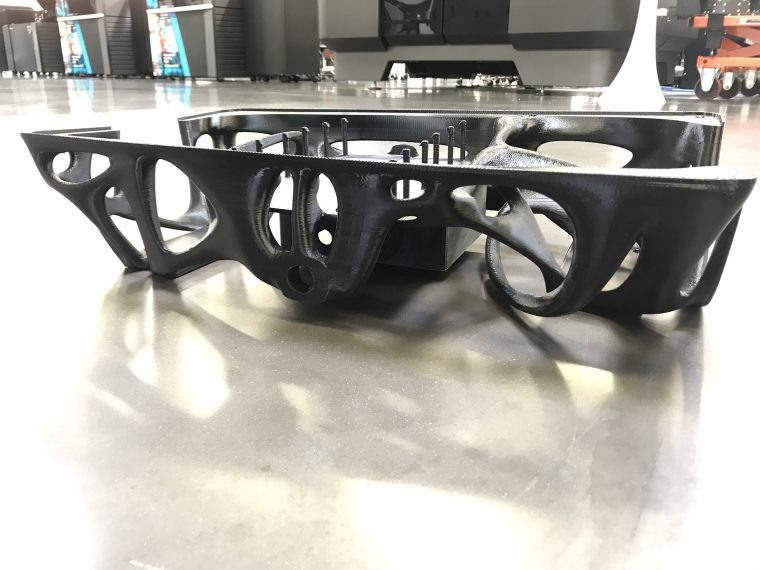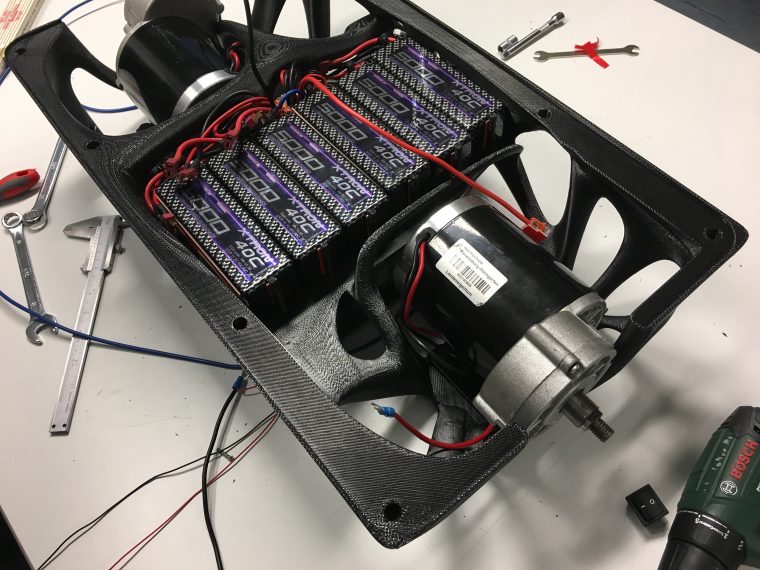
The first fully-functional 3D printed prototype of the self-balancing scooter featuring Stratasys 3D printed frame and platform, produced in tough Nylon6 material
The development and continued integration of 3D print technology into nearly every aspect of life is exciting. Every day new stories of the boundaries being pushed and innovations being realized through the application of this technology pour in. It’s important in all of this, however, to also take time to study not just the sexy headlines of what can be created but how the very methods themselves actually inform the process of approaching the problems at hand. An important part of distinguishing a trend versus a sustained methodology lies in this type of self study. As part of just such introspection, students at the University of Applied Sciences Ravensburg-Weingarten undertook to approach a project in which the very point was to examine the benefits of the integration of 3D tech into the process.
The students involved were tasked with creating a self-balancing scooter and to build their process by thinking ‘additively’ from the very beginning. The result was a scooter that not only took full advantage of the customization possibilities offered through advanced manufacturing but also that clearly demonstrated one of the other primary benefits of 3D printing technology in the form of significant time reductions from start to finish. In fact, the time savings created by integrating 3D tech from the beginning are estimated to be at around 85%. The impact of the technology not only on the final outcome but on the process by which the product was developed was described by Dr. Markus Till, Head of the Department of Mechanical Engineering at the University:
“We realized that 3D printing offers the best possible manufacturing solution for an ideal executable product development method for a customized product. We designed the entire product development process around Stratasys’ additive technologies, enabling us to quickly design and produce a fully-functional prototype of a geometry that was previously too complex to be created through any other traditional method – offering the first viable alternative for quick and cost-effective customized production.”

Very complex frame design of the self-balancing scooter 3D printed with Stratasys’ Fortus 900mc Production 3D Printer – not achievable using subtractive processes
The scooter itself somewhat resembles the Segway without all of the clunky electronics in the handlebar and central column. Both the frame and component parts of the platform were 3D printed using Nylon 6 material, a particularly durable FDM material that was designed for use in prototypes created to understand functional performance. The parts themselves were printed on the large format Stratsys Fortus 900mc Production 3D printer. This allowed for even the larger pieces of the scooter to be 3D printed in a single piece. Finally, in order to give the platform better grip and prevent accidents due to slipping, a cover was created by printing in Agilus30 material on the Stratsys Connex3 Color Multi-material 3D printer. Till compared the process by which the prototype was created when thinking additively to that of traditional methods:
“Using traditional manufacturing processes such as milling or molding, the most notable challenge is developing the scooter’s body frame, which houses several parts from motor to electrics. Firstly, the structure of the part is too complex for subtractive methods, while the turnaround times are too time-intensive to meet the production schedule. As a result, we’ve seen students start to ‘think additively’, leveraging the capabilities of the 3D printing to design with more freedom and with customization in mind…With traditional methods, the manufacturing process would have taken us three weeks. With Stratasys 3D printing this phase was reduced to four days.”

3D printing the self-balancing scooter frame over traditional methods allowed the student project team to save up to 85% in time during the manufacturing stage of the project
Even the greatest skeptic of 3D printing would have to admit that this is a significant improvement if process time is an important factor. That same skeptic would also have to acknowledge that there is no putting AM’s genie back in its bottle either as it is being integrated into education at earlier levels each year. If today’s students are going to be prepared to enter the marketplace of making, more of them are going to need to be able to not just operate 3D machinery but to mold their very thought processes to take full advantage of its potential. As explained by the President of Europe, Middle East, and Africa (EMEA) at Stratasys, Andy Middleton:
“The University of Applied Sciences Ravensburg-Weingarten is a prime example of how designers, engineers and manufacturers are involving additive manufacturing from the outset of product design to be able to exploit its benefits through the entire development cycle. As such, we believe it’s crucial that the next generation of engineers are given the right education to prepare them for the requirements of engineering within industry. As we see more educational institutions continue to adopt additive technologies, we expect to see more students learn the relevant skills and tools to be competitive for top engineering and manufacturing jobs.”
This doesn’t mean that there is a conflict between traditional manufacturing and advanced manufacturing, but rather that a truly holistic approach requires understanding the costs and benefits of each approach, with the end result being a need for a bilingual ability to move back and forth and speak either language as needed. The dramatic time savings demonstrated through this project help us to understand better how this fluency can be appropriately directed as well as what we should realistically be expecting from it. There’s still a lot of pie in the sky hope that 3D printing will revolutionize everything we know and it is only through well documented and focused attention that we can begin to sort the true benefits from the dreams, and the dreams from the delusions.
Discuss this article and other 3D printing topics at 3DPrintBoard.com or share your thoughts below.
Subscribe to Our Email Newsletter
Stay up-to-date on all the latest news from the 3D printing industry and receive information and offers from third party vendors.
You May Also Like
3D Printing Financials: Fathom Struggles in Financial Quicksand During Critical Transition
Facing a year of key transitions and financial pressures, Fathom (Nasdaq: FTHM) has filed its annual report for 2023 with the U.S. Securities and Exchange Commission (SEC). The document outlines...
Latest Earnings Overview for Australian 3D Printing Firms Titomic and AML3D
Australian 3D printing manufacturing firms Titomic (ASX: TTT) and AML3D (ASX: AL3) reported their financial results for the period from July to December 2023, marking the first half of their...
3D Printing Webinar and Event Roundup: April 7, 2024
Webinars and events in the 3D printing industry are picking back up this week! Sea-Air-Space is coming to Maryland, and SAE International is sponsoring a 3D Systems webinar about 3D...
3D Printing Financials: Unpacking Farsoon and BLT’s 2023 Performance
In the Chinese 3D printing industry, two companies, Farsoon (SHA: 688433) and Bright Laser Technologies, or BLT (SHA: 688333), have recently unveiled their full-year earnings for 2023. Farsoon reported increases...































